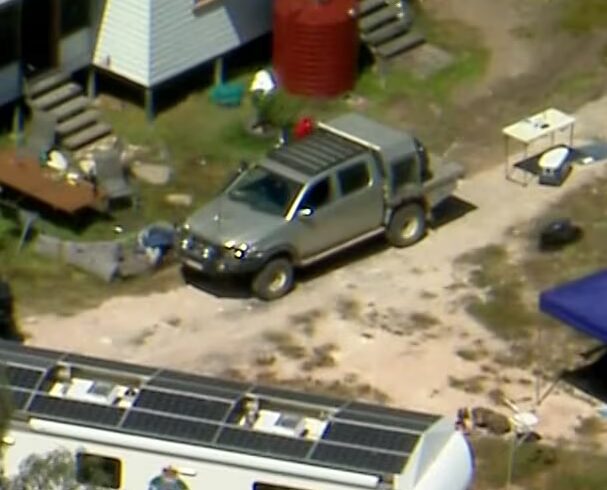
Nearly three years ago, six people were fatally shot on a remote property in Wieambilla, Queensland.
Two police officers, Constables Matthew Arnold and Rachel McCrow, and a neighbour, Alan Dare, were fatally shot by Gareth, Stacey and Nathaniel Train, who were later killed in a stand-off with police.
Their digital footprint soon revealed that this trio were inspired to ambush and execute their victims by their conspiracy theory and religious-inspired delusions of persecution that they were sharing online until just moments before their deaths.
The circumstances of this tragedy are unusual anywhere. In a country like Australia, with low levels of gun violence and extremism, an event like this was an anomaly.
At least, it was until earlier this year when a self-proclaimed sovereign citizen with a history of anti-police grievances, Dezi Freeman, allegedly killed two police officers and went on the run.
Suddenly, two violent tragedies became spoken of in the same breath as Australia tried to come to terms with these acts of violence, whose perpetrators had digital footprints in conspiratorial corners of the internet.
A poster honouring Alan Dare, who was shot and killed during a siege in the Queensland community of Wieambilla on December 12, 2022. (
ABC News: Cindy Wockner
)
A set of dominoes
As someone who has closely reported on both the Trains and Freeman, including having just co-authored a book on conspiracy theories in Australia, I have eagerly awaited seeing the conclusions of the inquest into what happened on December 12, 2022.
On Friday, Queensland state coroner Terry Ryan published his findings from the investigation
It turned five weeks of detailed hearings, testimony from more than 50 witnesses and thousands of pages of documents into the definitive account of what happened and 10 recommendations for how to stop something like this from happening again. (Crucially, inquests examine the deaths of all involved, including the Trains as well as their victims).
Town not ‘defined’ by Wieambilla shooting tragedy
Coronal inquest reports lay out incidents as a simple, linear chain of events, like a set of dominoes toppling towards an inevitable conclusion.
In this case, the Wieambilla inquest looked forensically at the tick-tock of what happened that day from the moment that the police stepped over the Trains’s gate into their property. Then it goes further back to look at what led the police to attend the property. Later, it goes all the way back to the birth of Gareth Train.
With the facts of the case established, the coroner comes up with recommendations about what the government could do to prevent similar cases.
Ryan’s recommendations included suggesting that police consider using drones, training for Triple Zero operators, and mental health checks as part of gun purchases.
Queensland Police Deputy Commissioner Cheryl Scanlon says Wieambilla was a “dark day” for the service. (ABC News: Lucas Hill)
The inquest’s findings
The families of the two constables told the media that they were disappointed with the findings.
Despite the format of the report — the fall of one domino leading to the toppling of another — Ryan’s findings make clear that he does not view the sequence of events as predetermined or as straightforward as the timeline of events lays out.
That is because Ryan’s task is not figuring out how Wieambilla itself could have been averted, but incidents like Wieambilla.
Issues like the NSW Police’s failure to pass on threatening emails from Gareth Train to Queensland Police, or the lack of body armour worn by police, may have played a role in the specific events turning out the way that they did. But, Ryan finds, changing that would not have avoided tragedy in one form or another.
Families of murdered officers ‘disappointed’ by Wieambilla inquest findings
One of the findings of the inquest that received the most attention was that the Trains did not commit a terrorist act because they were experiencing delusions of persecution. They wrongly believed they were under attack and defending themselves because of a rare shared delusional disorder, the inquest found.
That mental illness was a significant driver of the attack led to a recommendation to increase funding to the Queensland Fixated Threat Assessment Centre (QFTAC), a joint group staffed by both police and psychiatrists from the state’s forensic mental health service that identifies fixated individuals through abnormal communications with public office holders and provide them with mental health interventions and by addressing other risk factors.
But, again, the report defies a simple narrative that this would have avoided the Wieambilla shootings.
Ryan noted that the shooting was not a consequence of a system failure because the Trains were not known to the state’s mental health system, that no authority had any reason to believe they were suffering from mental health issues, and that an expert was only “moderately confident” that the Trains would have received a QFTAC referral if identified.
In fact, the report concluded “that no government or other authority had information which would have indicated a risk that the Trains would act in the way they did on 12 December 2022”.
This finding seems to contradict a later conclusion from Ryan about Gareth Train’s online activities: “It is concerning that the online activities of Gareth Train in the years leading up to December 2022, carried out in plain sight, do not appear to have been monitored or drawn to the attention of law enforcement agencies.”
Loading
A digital footprint
Reading Gareth Train’s posts online, or emails, messages and phone call transcripts tendered in the trial, makes it seem almost inevitable that something like this was going to happen.
I experienced the same thing when I uncovered Dezi Freeman’s history of Facebook and Telegram posts showing that he openly fantasised about violence for years before the alleged incident.
My friend, the killer
This experience — viewing an individual’s trail of communications in hindsight with full knowledge of what they would go on to do — is vastly different to how we might interpret the same documents before we know how it plays out.
Tendered to a court or presented in an article after the fact, it seems simple that one would lead to the other.
But in the messy context of reality, it is much different. Train’s posts on obscure conspiracy blogs were remarkably unnotable, as they came in a sea of other comments from similarly aggrieved and angry people.
So, too, were Freeman’s. In fact, after the Porepunkah shooting, I remembered that I had once seen footage of Freeman telling a magistrate in court that they were under arrest.
It was strange, no doubt, but fundamentally indistinguishable from the many other people spouting similar ideas and doing similar stunts. Nothing I have seen suggests we can tell the few who will graduate from talk into action.
Predictable can mean preventable
So what can we take from our failure to identify these individuals as violent before it happened? Is the answer doubling down on using artificial intelligence to “rapidly build intelligence profiles of those engaged in online behaviour” as Ryan mentions in the report, but stops short of recommending?
One answer is that it might not be necessary.
A paper published by two British academics in 2000 examined 40 homicides committed by someone with a mental illness.
What it found was that just about a quarter of the homicides were predictable. That is, the vast majority of homicides could not have been reasonably suspected to have happened based on a risk assessment of the perpetrator.
The inquest sought to learn from the Wieambilla shootings to help ensure the tragedy becomes an isolated incident. (Supplied)
However, it found that two-thirds were preventable. That is because solutions like improving mental health care and responding to parent relapse could limit violence, regardless of whether the person had been assessed as being a high risk or not.
At a population level, we know some will become violent; we don’t know which ones, but we can help all of them.
The same thinking can be applied here. Mental health clearly played a large role. In fact, the first sentence of Gareth Train’s biography in the report notes that he was born prematurely — something that one expert witness speculated might have left him with brain damage that contributed to his cognitive issues.
The enormous disruption of the COVID-19 pandemic led to widespread social isolation, a backlash from some to the unprecedented government intrusion in the form of public health orders and mass uncertainty. At a national level, the wealth and perception of corruption appear to influence how much a population accepts conspiracy theories. It makes sense that people are more likely to seek alternative narratives when their lives are hard and unfair.
‘I do not consent’: How pseudolaw supports ‘sovcit’ ideas
It is these enormous structural factors that lay the groundwork for the specific, unique set of circumstances that led to an act as rare, extreme and aberrant as this. Most lines of dominoes do not lead here, but the more that are toppling, the more likely it is that one ends up falling like this.
It can feel unsatisfying to conclude that maybe it’s unreasonable to expect that the Trains’s attack at Wieambilla could be predicted. For grieving families, it might even feel like betrayal.
But an acknowledgement that it is impossible to be able to ever confidently predict who is going to lash out like this is not the same as a surrender. (Ironically, this uncomfortable feeling of uncertainty is a key motivation for why people embrace the simplicity of conspiracy theories.)
The Wieambilla inquest report avoids the simple narrative that we can fully neutralise future risk of extreme violence by tweaking a few policies here and there. This is not a failure to grapple with the issues, but a clear-eyed understanding of the complexities that brought us here and the solutions that can help.
Cam Wilson is the co-author of Conspiracy Nation and a technology reporter who covers the intersection between internet culture, online extremism and politics.





